- Reclamation
- Upper Colorado Region
- Colorado River Storage Project
- Glen Canyon Unit
Glen Canyon Unit
Glen Canyon Dam, rising 710 feet above bedrock within the steep, rust-colored sand-stone walls of Glen Canyon, was constructed to harness the power of the Colorado River in order to provide for the water and power needs of millions of people in the West.

Water rushing from first two jet tubes opened for high-flow experiment at Glen Canyon Dam - March 5, 2008

View from top of dam of all four jet tubes open releasing water for high-flow experiment - March 5, 2008

Glen Canyon Dam and all four jet tubes open releasing water for high-flow experiment - March 5, 2008

Night view of Glen Canyon Dam and all four jet tubes open releasing water during high-flow experiment - March 5, 2008

Aerial view of Glen Canyon Dam and Lake Powell

Glen Canyon Dam, Powerplant and transformer deck

Glen Canyon Dam with all four jet tubes open during March 2006 high-flow experiment

Glen Canyon Dam penstock intakes - July 2004

Glen Canyon Dam penstock intakes - July 2008

Transmission towers on the canyon wall - Glen Canyon Dam

Carl Hayden Visitor Center at Glen Canyon Dam

Generators inside Glen Canyon Powerplant

View of Carl Hayden Visitor Center from base of Glen Canyon Dam

View of Glen Canyon Dam from downstream viewpoint

Glen Canyon Dam construction cableways - 1963

Commemoration of 50 percent completion of oncrete haul for dam construction

Glen Canyon Dam and bridge construction - 1963

Aerial view of Glen Canyon Dam during construction - 1963

Aerial of the dam site and work on the keyway - 1960

Glen Canyon Dam spillway construction - 1962

Surveyors on canyon wall - 1962

View of coffer dam - 1960

First Lady, Mrs. Lyndon B. Johnson dedicates the dam -1966

Lake Powell filled completely in 1980

Aerial view of Page, Arizona - 1983

Aerial view of Page, Arizona - 1963

Glen Canyon dam construction and penstock installation - February 1961

Glen Canyon Bridge dedication ceremony - 1959

Glen Canyon switchyard construction - 1964

Aerial view of trailer park housing for workers - 1958

Visitor center construction - March 1966

Boats on Lake Powell

Antelope Marina - Lake Powell

Boat ramp at Wahweap Marina

Aerial view of scenic Lake Powell

Aerial view of scenic Lake Powell

Aerial view of Wahweap Marina - Lake Powell

Houseboat on Lake Powell

Beach at Wahweap - Lake Powell

Scenic Colorado River at Lees Ferry

Boating on Lake Powell

Boats at Antelope Marina

Recreation at Lone Rock Beach

Horseshoe Bend downstream from Glen Canyon Dam

Kids jumping off houseboat near Wahweap - Lake Powell

Rafting below Lees Ferry

Historic Lees Ferry Fort

Rafters at Lees Ferry prepare for trip through the Grand Canyon

Sailboat on Lake Powell

Hikers standing beneath Rainbow Bridge

Boats on Wahweap Marina
Glen Canyon Dam is the second highest concrete-arch dam in the United States, second only to Hoover Dam which stands at 726 feet. The 25.16 million acre-feet of water storage capacity in Lake Powell, created by Glen Canyon Dam, serves as a ‘bank account’ of water that is drawn on in times of drought. This stored water has made it possible to successfully weather extended dry periods by sustaining the needs of cities, industries, and agriculture throughout the West.
Hydroelectric power produced by the dam’s eight generators helps meet the electrical needs of the West’s rapidly growing population. With a total capacity of 1,320 megawatts, Glen Canyon Powerplant produces around five billion kilowatt-hours of hydroelectric power annually which is distributed by the Western Area Power Administration to Wyoming, Utah, Colorado, New Mexico, Arizona, Nevada, and Nebraska. In addition, revenues from production of hydropower help fund many important environmental programs associated with Glen and Grand canyons.
The designation of Glen Canyon National Recreation Area in 1972, underscores the value and importance of the recreation benefits associated with Lake Powell and the Colorado River downstream of the dam. The recreation area is managed by the National Park Service.
Glen Canyon Dam is the key water storage unit of the Colorado River Storage Project, one of the most complex and extensive river resource developments in the world. Without it, development of the Upper Colorado River Basin states’ portion of the Colorado River would not have been possible.

Lake Powell
Formed by the waters of the Colorado River behind Glen Canyon Dam, Lake Powell’s 1,960 miles of winding shoreline (when full) and 186 mile-length make it the second-largest reservoir in the United States. Lake Mead, formed by Hoover Dam is the largest.
Lake Powell began filling on March 13, 1963 and completed filling on June 22, 1980 reaching elevation 3,700 feet above sea level with a total capacity of over 25 million acre-feet of water. Lake Powell extends through the main corridor of Glen Canyon as well as into over 90 side canyons that extend outward.
Named after Major John Wesley Powell who successfully navigated the first expedition down the Colorado River through the Grand Canyon in 1869, Lake Powell offers visitors spectacular scenery and numerous recreational opportunities. Managed by the National Park service, the Glen Canyon National Recreation Area is visited by over 3 million people each year.
In addition to its significant recreation value, Lake Powell functions as a vast ‘bank account’ of water that can be drawn on during dry years. Lake Powell provides long-term carryover water storage that allows the Upper Basin states of Wyoming, Colorado, New Mexico, and Utah to use their share of the Colorado River while still providing the required delivery of water to the Lower Basin states of Arizona, California, and Nevada. As drought conditions persist in the Southwest, the water storage in Lake Powell is especially critical.
As Lake Powell fulfills its intended purposes, it’s natural for the elevation of the lake to fluctuate depending on the amount of spring runoff from the mountains, deliveries to the Lower Basin, and the amount of water carried over from the previous year. Each year, the lake level increases between May and July from runoff followed by a decrease in lake level throughout the remainder of the year, leaving a visible ring along the shoreline. The amount of fluctuation varies each year but during extended periods of drought, Lake Powell’s elevation could drop by more than 200 feet below its maximum elevation.
Because of the many significant benefits provided by Lake Powell, Congress continues to include a direct prohibition concerning any planning actions or expenditure of public funds related to consideration or actions toward draining Lake Powell. Former Reclamation Commissioner, John W. Keys III said, "Previous administrations of both political parties, as well as the U.S. Congress, have said that Glen Canyon Dam is here to stay because it is serving millions of people in the Southwestern United States. Congress, through the passage of the Grand Canyon Protection Act of 1992, clearly stated that the dam and reservoir have a place in the tapestry of the country." Reclamation is committed to operating Glen Canyon Dam in accordance with the Law of the River and all applicable environmental laws.
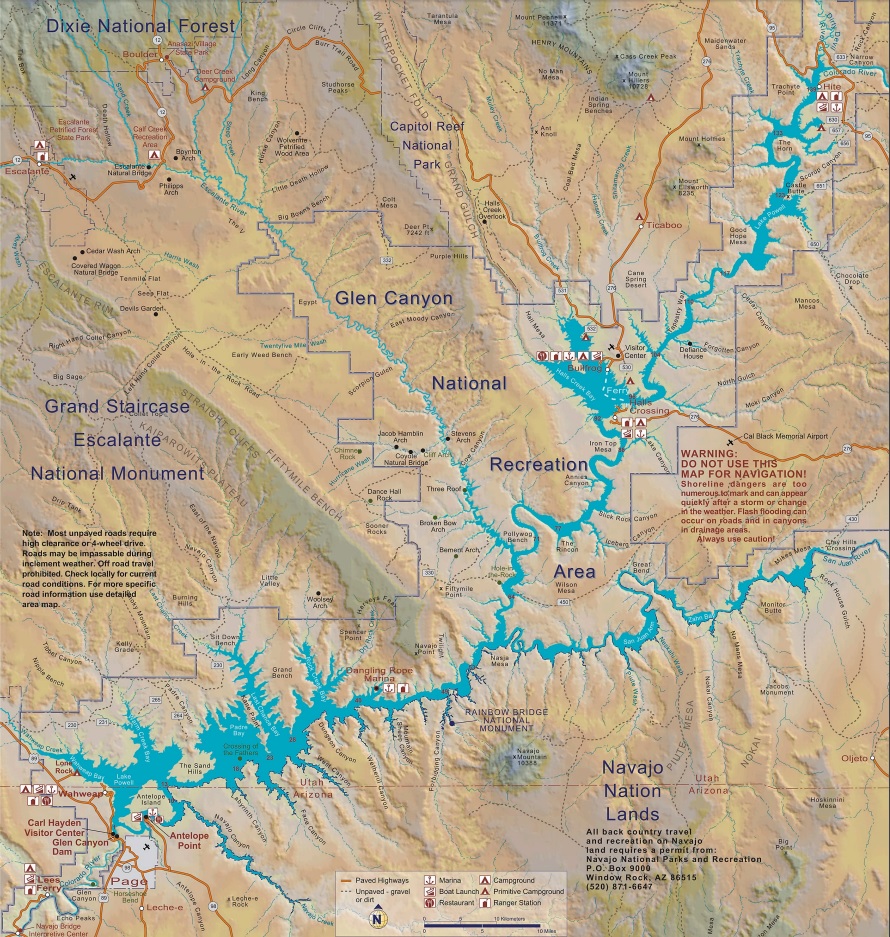
Looking for water data? WATER OPERATIONS
The day-to-day operation and maintenance of Glen Canyon Dam and Powerplant is performed by the Glen Canyon Field Division of the Power Office and is funded from revenue received from the sale of Colorado River Storage Project power. The powerplant, consisting of eight hydroelectric generating units with a combined capacity of 1,320 megawatts, is a significant part of the CRSP power resources with 79 percent of the total CRSP capacity.
Glen Canyon Dam is the principle water storage unit of the Colorado River Storage Project . The CRSP was authorized on April 11, 1956, to regulate the flow of the Colorado River; provide for flood control; provide for storage and delivery of water for irrigation, municipal, industrial, and other beneficial purposes; and generate electrical power. The CRSP also provides for recreation and improves conditions for fish and wildlife. Construction of the CRSP water storage facilities, including the Initial Units – Glen Canyon Dam, the Aspinall Unit, Flaming Gorge Dam and Navajo Dam – were critical to the development of the Upper Colorado River Basin's water and power resources.
The initial operation of Glen Canyon Dam focused on storing and releasing water to the Lower Basin states pursuant to the Colorado River Compact and generating power. Water releases through the powerplant fluctuated as the powerplant responded to power system load changes, peak load demands, regulation of the power system and power system emergencies.
New challenges are arising as drought has impacted the Colorado River Basin. As dry years continued, the ongoing drought prompted the Secretary of the Interior to request the seven Colorado River Basin states and Reclamation to establish guidelines and coordinated management strategies for the operation of Lake Powell and Lake Mead under low reservoir conditions. On December 13, 2007, the Secretary signed new interim operational guidelines that established rules for shortages, surpluses, and coordination of operations between Lake Powell and Lake Mead, and encourage new initiatives for water conservation. In 2020, Reclamation completed a 7.D. Review (consistent with Section XI.G.7.D of the 2007 Interim Guidelines Record of Decision) that was a retrospective look at past operations and actions; it is not a consideration of future activities. Through this review, Reclamation built a solid technical foundation that informs future consideration of operations and brings partners, stakeholders, and the public to common understanding of past operations and their effectiveness.
In 2019, Reclamation and the seven Colorado River Basin states signed the Drought Contingency Plans for the Upper and Lower Colorado River Basins, which are designed to reduce risks from ongoing drought and protect the single most important water resource in the western United States.
The Drought Response Operations Agreement is one element of the Upper Basin DCP. The first response within DROA is to reallocate monthly volumes at Glen Canyon Dam to increase elevations to the extent possible within the current operational flexibilities. DROA further identifies a process that includes the ability to temporarily move water stored in CRSP's Initial Units above Lake Powell – Aspinall, Flaming Gorge, and Navajo – to Lake Powell to further increase elevations during times when projections indicate critical threshold levels will be reached, including the target elevation of 3,525 feet. This elevation provides a 35-foot buffer above the minimum power pool of 3,490 feet. Pursuant to DROA, Reclamation and the Upper Division States are working on a Drought Response Operations Plan with the goal of implementing operational measures to augment water deliveries from the CRSP Initial Units to prop up Lake Powell.
As the Colorado River Basin continues to experience its worst drought in recorded history and water stored in Lake Powell and Lake Mead have reached their lowest volumes since the reservoirs started filling, Reclamation continues to closely monitor hydrologic conditions and projections, and foster productive discussions and collaborative decision-making about the future of Lake Powell and Lake Mead.
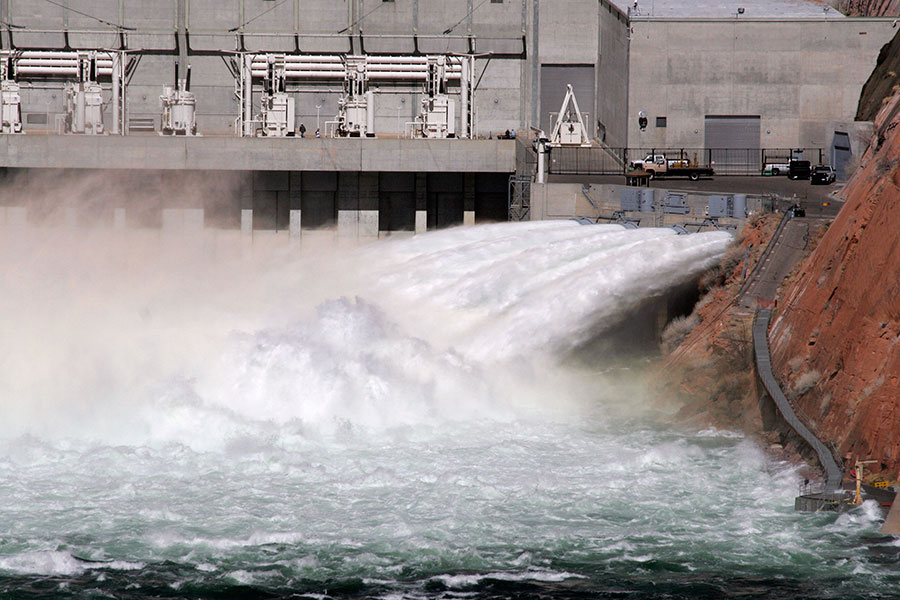
The authorization of the Colorado River Storage Project Act by Congress on April 11, 1956 initiated the construction of Glen Canyon Dam, the key unit of one of the most extensive and complex river resource developments in the world. The first dynamite blast in Glen Canyon occurred on October 15, 1956 when President Dwight D. Eisenhower pressed a telegraph key from Washington D.C. to set off the explosion signaling the beginning of construction.
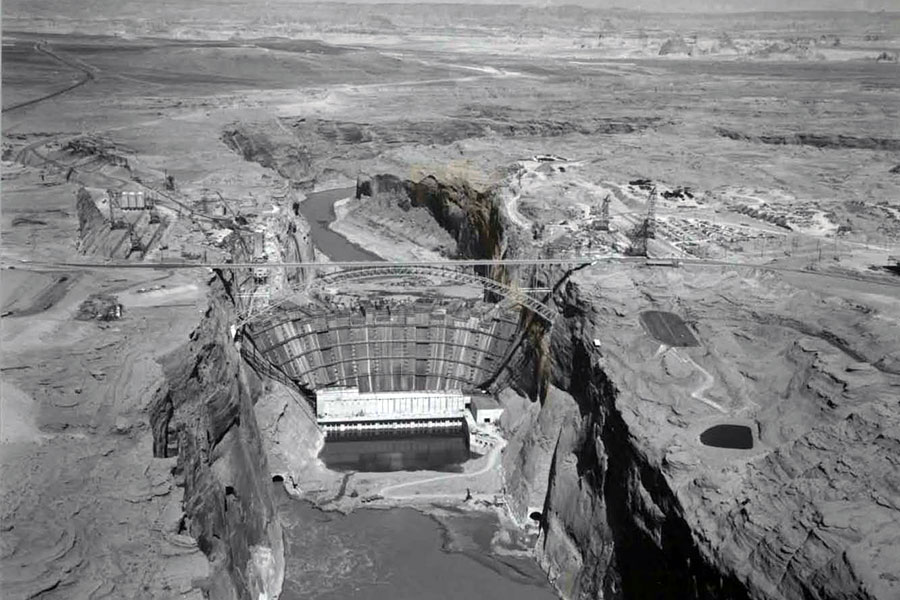
Glen Canyon Dam
Once completed, Glen Canyon Dam would provide vital water storage that would allow the Upper Colorado River Basin states of Utah, Colorado, Wyoming, and New Mexico to utilize their share of the Colorado River, especially during times of drought, while providing the required delivery of water to the Lower Basin states of California, Nevada, and Arizona.
When Reclamation engineers and geologists began looking for a suitable location to build Glen Canyon Dam, several criteria had to be met: the area forming the basin could contain an immense amount of water, the canyon walls and bedrock foundation were strong and stable enough to safely support the high dam, and the dam must be economically feasible to construct. Glen Canyon proved to be the perfect location, although because it was such a remote site, it presented some unique construction challenges. Because there were no rail facilities near the construction site, a bridge was built to allow trucks to deliver material and equipment across the canyon. Construction of the 1,271 foot-long steel-arch bridge 700 feet above the river, was completed in January 1959, reducing a 200-mile trip to cross the river to less than a quarter mile. State highways were extended to the remote construction site and the Glen Canyon Bridge was constructed across the Colorado River to join the highways. Subsequently, the bridge was transferred to the state of Arizona.

Glen Canyon Bridge
In 1957, Reclamation constructed a government camp close to the dam site in northeastern Arizona to house construction workers and their families and to provide community services. This community called Page in honor of Reclamation Commissioner John C. Page. Reclamation managed the community of Page during and after construction of the dam until the town was transferred to private ownership pursuant to the 1974 legislation authorizing incorporation. Page became an incorporated town on March 1, 1975.
In order to construct the dam, the Colorado River had to be channeled around the site. A coffer, or temporary dam, was constructed upstream of the dam site to redirect the river through two, 3000 foot-long, 45 foot diameter diversion tunnels dug through the walls on each side of the canyon. The material excavated from the tunnels was used to make the coffer dam. With the river diverted, crews began work to excavate down 137 feet to the canyon’s bedrock for the dam’s foundation, and concrete placement began in June 1960. The concrete was transported in 24-ton capacity buckets via an aerial tramway strung across the canyon from a concrete mixing plant constructed nearby.

Historic photo of first aerial tram bucket during construction of Glen Canyon Dam
Construction continued 24 hours a day until on September 13, 1963, the last of over 400,000 buckets of concrete was placed. Glen Canyon Dam emerged from bedrock incrementally, as a series of blocks seven and a half feet high and up to 60 feet wide and 210 feet long, reaching a full height of 710 feet. Prior to reaching completion, Glen Canyon Dam began impounding water in March 1963 when the diversion tunnels were closed and Lake Powell was born. Due to the vast capacity of the reservoir, it took 17 years for Lake Powell to completely fill for the first time. On June 22, 1980, Lake Powell reached elevation 3,700 feet, with a total capacity of over 25 million acre-feet.

Photo of Lake Powell at total capacity in 1980
Installation of the powerplant equipment began after the dam was completed and the first hydroelectric power was generated on September 4th, 1964. By 1966, all eight generators had been installed and were working at full capacity. On September 22, 1966, the nation’s First Lady, Claudia “Lady Bird” Johnson, dedicated Glen Canyon Dam and Powerplant. Reclamation also constructed a switchyard at the dam, two 345 kilovolt (kV) transmission lines to Phoenix, Arizona and a 230 kV line to Farmington, New Mexico. In 1977, Reclamation’s power marketing and transmission functions were transferred to the Western Area Power Administration (Western).

Hydropower Generators at Glen Canyon Dam Powerplant
On either side of the dam are spillway tunnels constructed through the canyon walls measuring 48 feet in diameter at the intake point reducing in size to 41 feet in diameter. These spillways are used to release large quantities of water that exceed the combined release capacity of the powerplant and river outlet works. The spillways were used in 1983 when unpredicted weather patterns altered forecasts dramatically and caused a sudden and unforeseen high magnitude runoff. The extremely high water releases through the spillways caused cavitation damage in which the concrete in the tunnels was eroded. Subsequent redesign and reconstruction of the spillways incorporated new state-of-the-art technology in which “air slots” were built into the tunnels to eliminate the potential for cavitation.
During the unusual hydrologic circumstances of 1983, Glen Canyon Dam was never in danger of failing. Glen Canyon Dam, like all Reclamation dams, was constructed to the highest standards in the industry and has undergone continuous, exhaustive inspection and analyses. Reclamation’s Dam Safety Program standards have been peer reviewed and approved by dam safety experts from the Association of State Dam Safety Officials and other federal agencies.
Prior to the dam’s construction, extensive geologic studies were completed and then reevaluated in 1985 to determine if, following construction and filling of the reservoir, conditions had changed. No changes were identified. Seven complete studies were done in 1982, 1984, 1989, 1995, 1999, 2001, and 2004 under Reclamation’s Safety Evaluation of Existing Dams Program. All Reclamation dams are evaluated according to state-of-the-art engineering and geological standards.
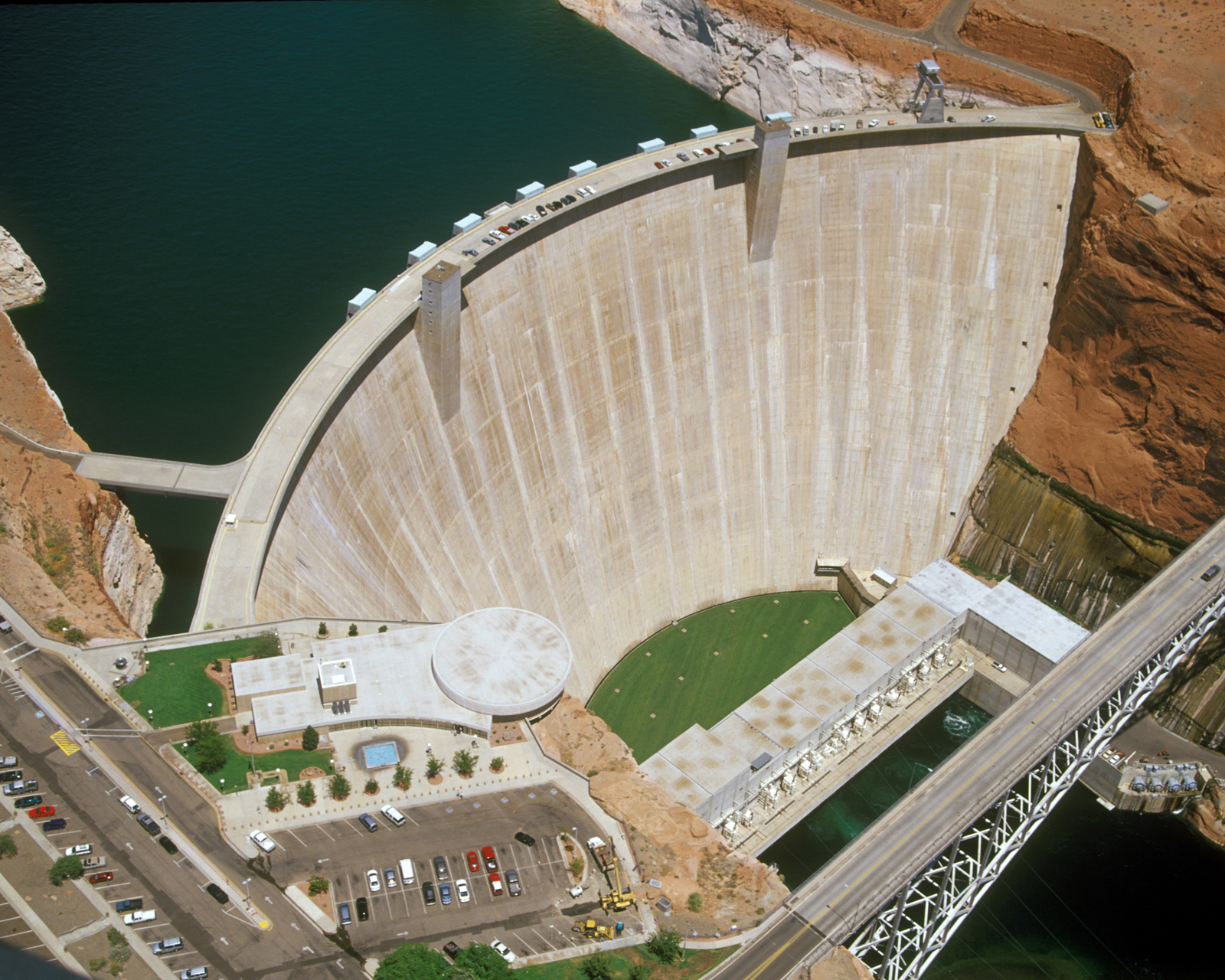
Aerial of Glen Canyon Dam
The process of adaptive management is an important tool used to improve decision-making through better understanding and management of complex, interrelated systems. It provides a framework for a collaborative, iterative process of experimentation, evaluation, and modification necessary to achieve improved results over time.
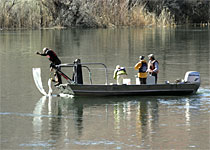
Researchers gathering data on Colorado
River at Lees Ferry
Because of the complexities of the Colorado River ecosystem in Glen and Grand Canyons and the impact of Glen Canyon Dam on the ecosystem, years of scientific research and development of a comprehensive environmental impact statement attempted to identify alternative operational strategies for the dam that would improve the downstream environment.
The Record of Decision for the Glen Canyon Dam Environmental Impact Statement, signed in 1996, specified operating parameters for Glen Canyon Dam and mandated adaptive management of the resources in Grand Canyon. The result was the Glen Canyon Dam Adaptive Management Program, designed to provide an organization and process for collaborative integration of dam operations, resource protection and management, and monitoring and research information.
Glen Canyon Dam is the principal water storage unit of the Colorado River Storage Project. Built in a virtually inaccessible area, it is one of the major engineering and construction achievements in the United States. Glen Canyon Dam impounds Lake Powell, the second largest reservoir in the country. The water supply stored in Lake Powell represents about 80 percent of the total combined storage capacity of the four CRSP initial units. This vital storage reservoir functions like a bank account of water to be drawn upon in times of drought. Without Glen Canyon Dam, the annual water delivery obligations to the Lower Basin could likely not be met during drought periods without creating significant shortages in the Upper Basin. Water stored in Lake Powell provides municipal, industrial, agricultural benefits as well as recreation opportunities and hydropower production.
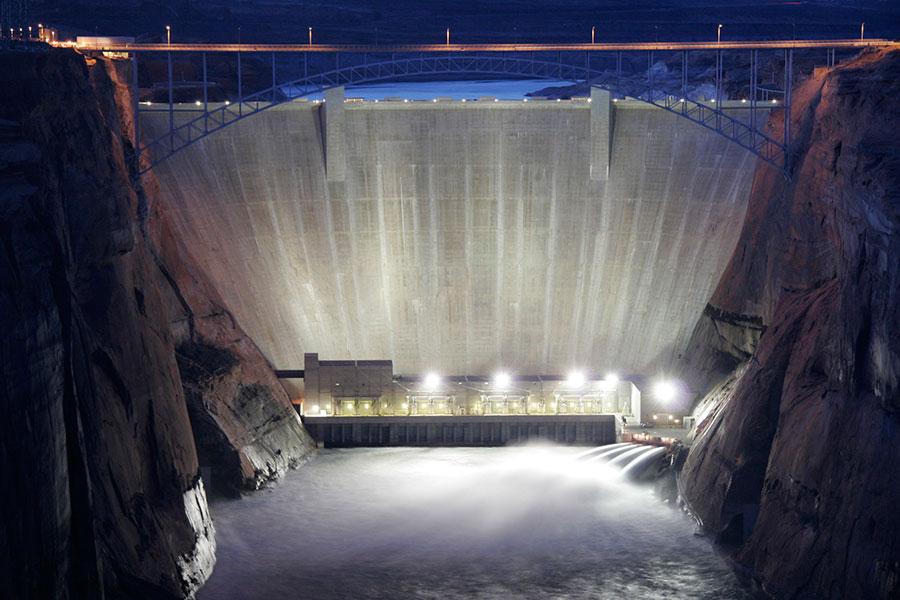
Glen Canyon Dam at Night During High Flow Release
| Type | Concrete arch |
|---|---|
| Construction period | 1957-1964 |
| Prime contractor | Merrit-Chapman & Scott |
| Height above bedrock | 710 feet (216 meters) |
| Height above original river channel | 583 feet (178 meters) |
| Crest length (arc at axis of dam) | 1,560 feet (475 meters) |
| Volume of concrete Dam only | 4,901,000 cubic yards (3,750,000 cubic meters) |
| Volume of concrete Powerplant only | 469,000 cubic yards (359,000 cubic meters) |
| Total Volume of concrete | 5,370,000 (4,110,000 cubic meters) |
| Capacity of concrete bucket | 24 tons (22 metric tons) |
| Number of bucks of concrete | 400,000 approximately |
| Cost of dam, powerplant & appurtenant structures | $245,000,000 |
| Number of generating units | 8 |
|---|---|
| Installed capacity | 1,320,000 kilowatts |
| Average annual power generation | 5 billion kilowatt hours |
| Type | Steel arch |
|---|---|
| Construction Period | 1957-1959 |
| Height above river | 700 feet (213 meters) |
| Span of bridge arch | 1,028 feet (313.3 meters) |
| Length of deck | 1,271 feet (387.4 meters) |
| Vertical rise of arch | 165 feet (50.3 meters) |
| Start of Storage | March 13, 1963 |
|---|---|
| Completion of initial filling | June 22, 1980 |
| Total capacity at full elevation 3,700 | 25,160,000 acre-feet (31,034 million cubic meters) |
| Surface area when full | 266 miles (68,900 hectares) |
| Length of lake | 186 miles (299 kilometers) |
| Miles of shoreline | 1,960 miles (3,150 kilometers) |
| Depth of water at dam when full | 560 feet (171 meters) |
Frequently Asked Questions
- Which is taller, Glen Canyon Dam or Hoover Dam? Which is larger, Lake Powell or Lake Mead?
- How long will Glen Canyon Dam last?
- Was anyone buried in the concrete during construction of Glen Canyon Dam?Why is it so cold inside the dam?
- What is the purpose of the large rock bolts in the canyon walls?
- How much water seeps through the dam?
- How much water from Lake Powell is lost into the atmosphere by evaporation?How much water was absorbed into the rock of the canyon walls during the initial filling of Lake Powell?
- What are the benefits of using hydroelectric power?
- Can the electricity produced at Glen canyon Powerplant be stored for use at a later time?
- How many kilowatt-hours of power does Glen Canyon Dam's powerplant produce annually?
- How much coal would it take to produce that same amount of power?
- Why does the lake look so blue and the river below the dam look so green?
- What is the large crane on top of the dam used for?
- How do vehicles get to the bottom of the dam?
- How is the Colorado River controlled?
- What percent of the nation's food is grown with Colorado River water?
- Are there any federally-listed endangered species living in the Grand Canyon below Glen Canyon Dam?
- Will Glen Canyon Dam be de-commissioned and Lake Powell be drained?
Which is taller, Glen Canyon Dam or Hoover Dam and which is larger, Lake Powell or Lake Mead?
Hoover Dam, which stands 726 feet (221 meters) tall, is 16 feet (4.9 meters) taller than Glen Canyon Dam which stands 710 feet (216 meters) tall.
When full, Lake Mead, which holds 28,537,000 acre-feet (35,200 million cubic meters) of water, is larger than Lake Powell which holds 25,160,000 acre-feet (31,034 million cubic meters) of water when full.
How long will Glen Canyon Dam last?
The dam itself could be in place indefinitely. However, it is currently estimated that the lake will fill with silt in 700 to 1,000 years. This might be considered the effective life of the project.
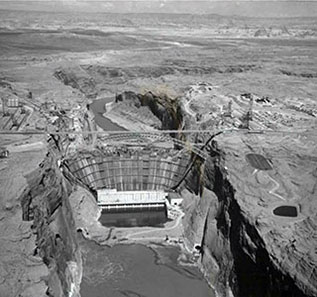
Glen Canyon Dam
Was anyone buried in the concrete during construction of Glen Canyon Dam?
During construction of Glen Canyon Dam, 18 workers died in various kinds of accidents. All of the bodies were recovered and accounted for and no one was buried inside the dam. Because of the construction techniques used to build the dam, it would have been impossible for a worker to be buried in the concrete. The enormous quantity of concrete used in the dam could not be placed all at one time. Instead, the dam was constructed as a series of concrete blocks, some as large as 60 by 210 feet (18 by 64 meters). It took many buckets of concrete, dumped one at a time, to fill each block. When each bucket load was released, there were many workers waiting to smooth out the concrete with special equipment. Once the concrete was spread out within each block, the maximum depth of fresh concrete that a worker could have fallen into was only 12 inches (30 centimeters). It would not have been possible for a worker to become trapped and buried in such a shallow depth of concrete.
Why is it so cold inside the dam?
The water that flows into Lake Powell originates as snowpack high in the mountains of Colorado. This icy water flows into the lake where it is so deep it cannot be warmed by the sun. As a result, the temperature of the water deep below the lake’s surface is about 44 degrees F (7 degrees C) year-round, keeping the dam cold inside. The temperature inside the dam remains fairly constant at 50 degrees F (10 degrees C) year-round.
What is the purpose of the large rock bolts in the canyon walls?
Hundreds of rock bolts were installed by high scalers to reinforce the canyon walls and prevent rock slabs from falling. The high scalers were suspended from long cables attached to windlasses on the rims of the canyon walls and drilled holes from 45 to 75 feet (14 to 23 meters) into the Navajo sandstone, inserted the bolts with expansion anchors, then forced concrete grout around them to secure them within the walls.
How much water seeps through the dam?
The sandstone walls of Glen Canyon contain natural fractures that allow water from Lake Powell to seep through them and into various tunnels in the dam. About 2,600 gallons per minute (9,841 liters per minute) seep into the dam, which is not a large amount of water for a structure this size. All water that leaks into the dam is routed through measurement weirs, then diverted to troughs at the base of the dam and is discharged to the river below. Dams are designed to handle seepage; no dam or foundation for a dam is absolutely impervious to seeping water. Seepage is controlled to prevent erosion. Seepage is not only tolerable, but normal.
How much water from Lake Powell is lost into the atmosphere by evaporation?
About two to three percent of the lake’s water evaporates into the atmosphere each year.
How much water was absorbed into the rock of the canyon walls during the inital filling of Lake Powell?
About 13.4 million acre-feet (16,500 million cubic meters), or almost one third of the reservoir’s capacity.

Glen Canyon Dam turbines
What are the benefits of using hydroelectric power?
Hydroelectric power is a clean, renewable form of energy that does not pollute the air, land, or water. Hydroelectric powerplants have low failure rates, low operating costs and are very reliable. In addition, the use of hydropower reduces our dependence on other more environmentally polluting energy sources. The hydropower plant provides system reliability for the overall regional power grid and is the primary unit to assist in a "black start" of the power system following a blackout failure. Under that scenario, hydropower facilities generate the power that is necessary to restart the system, which includes other power generating sources such as coal, natural gas, and nuclear facilities.
Can the electricity produced at Glen Canyon Powerplant be stored for use at a later time?
One drawback to electricity is that it cannot be stored for future use. Consequently, a utility company must have the capacity to provide power instantly to meet public needs. But since power demand varies greatly during the day and night, this job becomes quite complex. Since hydroelectric generators can be started and stopped almost instantly, hydropower is more responsive than other energy sources in meeting changing power needs.
How many kilowatt-hours of power does Glen Canyon Dam's powerplant produce annually?
Approximately 4.5 billion kilowatt-hours.
How much coal would it take to produce that same amount of power?
It would take 2.5 million tons of coal or 11 million barrels of oil each year to generate the same amount of power (based upon an approximate conversion rate of 580 kilowatt-hours per barrel of oil and 1,822 kilowatt-hours per ton of coal).
Why does the lake look so blue and the river below the dam look so green?
Lake Powell’s deep blue color results from the fact that it is a relatively clear body of water that reflects the color of the sky. The river below the dam looks green due to the feathery algae called cladophora that thrives in the river. This algae forms the basis of a highly productive food chain and is an important source of nutrients for many species living below the dam.
What is the large crane on top of the dam used for?
The main purpose of the gantry crane is to periodically withdraw the penstock fixed-wheel gates from beneath Lake Powell’s surface and place them on the dam crest where they can be inspected. The large crane can lift 165 tons (162 metric tons) with its big hoist and 25 tons (24.6 metric tons) with its smaller one.
How do vehicles get to the bottom of the dam?
There is a two mile (3.2-kilometer) dam-access tunnel through the east wall of Glen Canyon that begins on the mesa. The tunnel was blasted prior to construction of Glen Canyon Dam in order to transport heavy equipment and supplies to the canyon floor. The holes in the wall are adits or “windows” that were initially blasted out for the purpose of allowing excavated rock to be dumped to the river banks below. The adits now allow for circulation of air in the tunnel. The dam-access tunnel is not open to the public.
How is the Colorado River controlled?
The Colorado River is administratively controlled by numerous statutes, compacts, decrees, and a treaty with Mexico, collectively referred to as the “Law of the River.” In 1970, the Criteria for Coordinated Long-Range Operation of Colorado River Reservoirs was prepared in accordance with these formal regulations to form the rules by which the Colorado River reservoir system is operated. An operating plan is prepared each year to guide the operations of the Colorado River reservoirs.
What percent of the nation's food is grown with the Colorado River?
About 25 percent of the nation’s food is grown on approximately two million acres of land irrigated by Colorado River water.
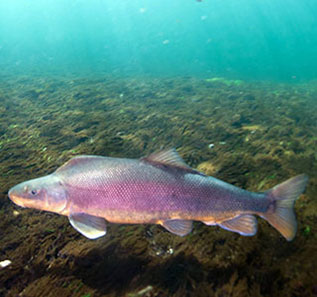
Razorback Sucker
Are there any federally-listed endangered species living in the Grand Canyon below Glen Canyon Dam?
Federal endangered species living in the Grand Canyon below the dam include the humpback chub, razorback sucker, southwestern willow flycatcher and the Kanab ambersnail.
Will Glen Canyon Dam be de-commissioned and Lake Powell drained?
There are no plans to de-commission Glen Canyon Dam and drain Lake Powell. Congress created Glen Canyon Dam and only Congress can remove it. Lake Powell provides vital long-term carry-over storage that is critical to the Upper Colorado River Basin states, especially in times of drought. Lake Powell helps sustain continued economic development in the rapidly growing Southwest by providing water for municipal and industrial use, agriculture, recreation, generation of electricity, and environmental needs. For these reasons, each year through appropriation legislation, Congress repeatedly says “no” to the proposal to drain Lake Powell.

Carl B. Hayden Visitor Center
Carl B. Hayden Visitor Center
At Glen Canyon Dam, the Carl B. Hayden Visitor Center is located 700 feet above the Colorado River overlooking Glen Canyon Dam and Bridge. The visitor center provides many interesting exhibits, audio-visual programs, and ranger presentations as well as a gift shop and an educational bookstore.
The Carl Hayden Visitors Center hours are 9 a.m. to 5 p.m. (MST). The theatre is now open.
Location:
Highway 89 North
Page, Arizona 86040
☏ Bookstore: (928) 608-6068

